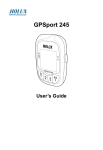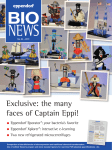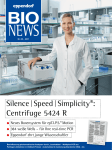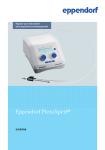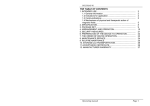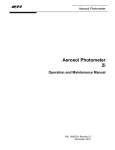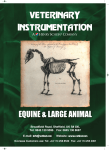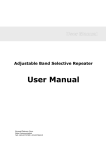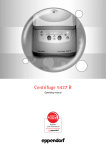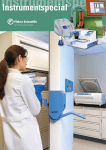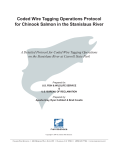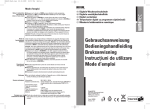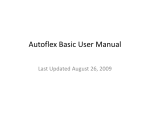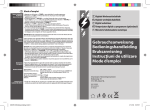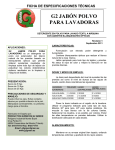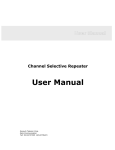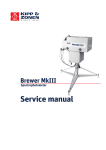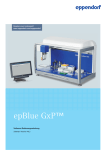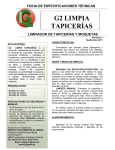Download BioNews 35 ENGLISH
Transcript
No. 3 5 – 2 011 Silence | Speed | Simplicity : Centrifuge 5424 R ® 384 White Wells – for Your Real-Time PCR Eppendorf Honors Young Scientists The Influence of UV Absorb Containers (Leach ing Substances Released from Plastic ables) on Photometric Analyses Natascha Weiß, Eppendorf AG, Wolf Wente and Stefanie Topp, Introduction Even routine application s have been shown to be compromi sed [3]. UV absorbing substance s from plastic containers are leached into the sample by laboratory applications requiring temperatures of 37 °C or above. Since these substance s absorb light in the same range as the absorbanc e maxima of nucleic acids and proteins, they can interfere with photometr ic detection reactions, thus providing a source of error with adverse effects on downstream application s. Therefore, the use of high quality consumables, which contain the least amount of leachable additives, is recommended. For the purpose of this Technical Report, experiments were performed in accordance with the publication by Lewis et al. [3]. This publication had described that the Eppendorf vessels tested achieved noticeably better results than competitors, but no data were shown. Hence, Eppendorf Safe-Lock Tubes 1.5 mL and Eppendorf 0.2 mL PCR tubes were here tested alongside comparable containers from other manufactu rers. Following incubation of water at different temperatures, absorbanc e scans and measurements in the UV range were performed in order to test whether componen ts were leached which could compromi se subsequent photometr ic analyses. July 2011 (BN 35) Hamburg, Germany Eppendorf Instrument e GmbH, Hamburg, Extinction can be estimated to be proportional to the amount of leached substances. A 2008 Science publication and other papers described that slip agents as well as biocides, which were washed from vessels and tips, are able to show activity in specific enzyme assays [1, 2]. As a consequen ce, false positive or false negative results are produced, which cannot be analyzed, thus leading to increased consumpt ion of time and financial resources. Materials and methods Three Eppendorf Safe-Lock Tubes 1.5 mL and comparab le tubes from two competitors were filled with 1 mL water (molecular biology grade) and incubated under the following conditions: a) 95 °C for 30 min, b) 70 °C for 30 min, c) 37 °C for 24 h. 0.2 mL PCR tubes from Eppendorf and two other manufactu rers were filled with 150 µL water (molecular biology grade) each. One half of the containers was subjected to a PCR protocol in a thermocycler (30 PCR cycles: 95 °C – 30 s / 60 °C – 30 s / 72 °C – 2 min), while the remaining vessels were incubated at room temperature (RT). Each sample was subjected to a scan across the range of wavelengths between 190 nm and 400 nm using a spectroph otometer, and the values for the groups of samples were 2.25 Absorbance scan Germany determined. Non-incub ated water was used to set the blank value. In an additional series of measurements in the BioPhotometer plus, 1 mL water (molecular biology grade) was incubated at 95 °C for 30 min in each of three Eppendorf Safe-Lock Tubes and tubes from three competito rs. Extinction values at 260 nm and 280 nm were determined, the mean values of the replicates and the SD were calculated . Furthermore, the factor 50 µg/mL was used to determine the theoretica l amounts of dsDNA from the measured extinction values. Results and discussio n Fig. 1 demonstra tes that water which was incubated in Eppendorf Tubes shows no significant extinction in relevant range of wavelengths. The samples taken from the tubes made by other manufactu rers show a distinct temperature-depende nt absorption profile. The highest values were measured at 95 °C (Fig. 1a). At 70 °C and 37 °C these values were lower (data not shown). of water following incubation at 95 °C for 30 min 0.10 2.00 0.08 1.75 Extinction [OD] New Box System for epT.I.P.S.® Motion 0.06 1.50 0.04 1.25 0.02 1.00 0.00 0.75 240 260 280 300 0.50 0.25 Eppendorf Manufacturer V Manufacturer A1 0.00 190 210 230 250 270 290 310 Wavelength [nm] 330 350 370 390 Fig. 1a: Absorbance spectrum of water following incubation of 1.5 mL tubes at 95 °C for 30 min Application Support: Europe, International: Tel. +49 1803 666 789 · E-Mail: North America: support@eppend Tel. +1 800 645 3050 · E-Mail: orf.com Asia Pacific: Tel. techserv@eppen +60 3 8023 6869 dorf.com · E-Mail: support_ asiapacific@epp endorf.com UV Absorbing Substances Released from Plastic Containers Influencing Photometric Analyses · Multiplex PCR Pathogen Detection in Whole Blood · Automated Plant DNA Purification · etc. Page 1 Editorial IMPRINT Editorial team: Berrit Hoff (Editor-in-Chief) Axel Jahns Jochen Müller-Ibeler Natascha Weiß Publisher: Eppendorf AG Barkhausenweg 1 Dear Reader! 22339 Hamburg Germany Quality, reliability, experience, innovation – these are words that people worldwide associate with Eppendorf. Whether a new technology, a service, or the further advancement of an existing product is concerned – every detail is geared towards the needs and requirements of our users. This approach has been crowned with success in every respect, as detailed in the annual report 2010 (p. 13). The success story of the Eppendorf microcentrifuges continues. Just recently, our Centrifuge 5424 R was awarded the “red dot design award 2011” (p. 4-5). Telephone: (+49) 40-53801-636 Fax: (+49) 40-53801-840 E-Mail: [email protected] Internet: www.eppendorf.com We welcome all readers’ articles for this publication. Our family of consumables has new additions: new twin.tec Plates with 384 wells for real-time PCR, as well as epT.I.P.S. Motion with a new ecological box system (p. 8-9). Eppendorf honors young scientists! On page 12 we are introducing to your the recent laureates of the Eppendorf research prizes. However, no responsibility is accepted for unsolicited manuscripts. Technical specifications subject to change. Errors and omissions excepted. Further to more information and product solutions for a wide range of tasks, as always the insert contains detailed Application Notes. Last, but not least, you will have the chance to win a set of 3 pipettes when you participate in our competition. Important note: The new products described may be launched at different times in various countries. We hope you enjoy the read! Please contact your local distributor for details. Your BioNews editorial team Copyright: All rights reserved, including graphics and images. © Copyright by Eppendorf AG, carbon neutral natureOffice.com | DE-299-920637 print production 2 BioNews No. 35 July 2011. Contents 4 8 10 In the spotlight Silence | Speed | Simplicity®: Centrifuge 5424 R . . . . . . . . . . . . . . . 4 Innovation 384 White Wells – for Your Real-Time PCR . . . . . . . . . . . . . . . . . 8 New Box System for epT.I.P.S.® Motion . . . . . . . . . . . . . . . . . . . 9 Straight from the lab Safe and Efficient Centrifugation . . . . . . . . . . . . . . . . . . . . . . 6 Reference Class Since 1994 . . . . . . . . . . . . . . . . . . . . . . . . 10 Interference with DNA Measurements by Plastic Consumables . . . . . . . . 8 News / Tips epMotion ® Performance Plans . . . . . . . . . . . . . . . . . . . . . . . 9 Nano Is All Around . . . . . . . . . . . . . . . . . . . . . . . . . . . . 10 Learning with Eppendorf Products . . . . . . . . . . . . . . . . . . . . 11 Eppendorf Honors Young Scientists . . . . . . . . . . . . . . . . . . . . 12 Installation and Operational Qualification . . . . . . . . . . . . . . . . . 13 Prize Competition . . . . . . . . . . . . . . . . . . . . . . . . . . . . . 14 Service Reply fax / Readers’ service . . . . . . . . . . . . . . . . . . . . . . . . . 15 Natascha Weiß, Wolf Wente, Stefanie Topp: The Influence of UV Absorb Containers (Leach ing Substances Released from Plastic ables) on Photometric Analyses Natascha Weiß, Eppendorf AG, Wolf Wente and Stefanie Topp, Introduction Extinction can be estimated to be proportional to the amount of leached substances. A 2008 Science publication and other papers described that slip agents as well as biocides, which were washed from vessels and tips, are able to show activity in specific enzyme assays [1, 2]. As a consequen ce, false positive or false negative results are produced, which cannot be analyzed, thus leading to increased consumpt ion of time and financial resources. Even routine application s have been shown to be compromi sed [3]. UV absorbing substance s from plastic containers are leached into the sample by laboratory applications requiring temperatures of 37 °C or above. Since these substance s absorb light in the same range as the absorbanc e maxima of nucleic acids and proteins, they can interfere with photometr ic detection reactions, thus providing a source of error with adverse effects on downstream application s. Therefore, the use of high quality consumables, which contain the least amount of leachable additives, is recommended. July 2011 (BN 35) Materials and methods Three Eppendorf Safe-Lock Tubes 1.5 mL and comparab le tubes from two competitors were filled with 1 mL water (molecular biology grade) and incubated under the following conditions: a) 95 °C for 30 min, b) 70 °C for 30 min, c) 37 °C for 24 h. 0.2 mL PCR tubes from Eppendorf and two other manufactu rers were filled with 150 µL water (molecular biology grade) each. One half of the containers was subjected to a PCR protocol in a thermocycler (30 PCR cycles: 95 °C – 30 s / 60 °C – 30 s / 72 °C – 2 min), while the remaining vessels were incubated at room temperature (RT). Each sample was subjected to a scan across the range of wavelengths between 190 nm and 400 nm using a spectroph otometer, and the values for the groups of samples were 2.25 Absorbance scan determined. Non-incub ated water was used to set the blank value. In an additional series of measurements in the BioPhotometer plus, 1 mL water (molecular biology grade) was incubated at 95 °C for 30 min in each of three Eppendorf Safe-Lock Tubes and tubes from three competito rs. Extinction values at 260 nm and 280 nm were determined, the mean values of the replicates and the SD were calculated . Furthermore, the factor 50 µg/mL was used to determine the theoretica l amounts of dsDNA from the measured extinction values. Results and discussio n Fig. 1 demonstra tes that water which was incubated in Eppendorf Tubes shows no significant extinction in relevant range of wavelengths. The samples taken from the tubes made by other manufactu rers show a distinct temperature-depende nt absorption profile. The highest values were measured at 95 °C (Fig. 1a). At 70 °C and 37 °C these values were lower (data not shown). of water following incubation at 95 °C for 30 min 0.10 2.00 0.08 1.75 Extinction [OD] For the purpose of this Technical Report, experiments were performed in accordance with the publication by Lewis et al. [3]. This publication had described that the Eppendorf vessels tested achieved noticeably better results than competitors, but no data were shown. Hence, Eppendorf Safe-Lock Tubes 1.5 mL and Eppendorf 0.2 mL PCR tubes were here tested alongside comparable containers from other manufactu rers. Following incubation of water at different temperatures, absorbanc e scans and measurements in the UV range were performed in order to test whether componen ts were leached which could compromi se subsequent photometr ic analyses. Hamburg, Germany Eppendorf Instrument e GmbH, Hamburg, Germany 0.06 1.50 0.04 1.25 0.02 1.00 0.00 0.75 240 260 280 300 0.50 0.25 Eppendorf Manufacturer V Manufacturer A1 0.00 190 210 230 250 270 290 310 Wavelength [nm] 330 350 370 Kristin Tessmar-Raible, Katharina Schipany, Sabine Przemeck: Removal of Fluorescently-labeled Sensory-neurosecretory Cells from Forebrain of Transgenic Medaka Embryos Using Eppendorf PatchMan™ NP 2 and CellTram® vario and Rowiak CellSurgeon . . . . . . . 3-4 Kristin Wessel, Roland Schmitz: Rapid and Reliable Multiplex PCR Pathogen Detection in Whole Blood by Using the VYOO ® Kit on the Mastercycler® pro . . . . . . 5-6 390 Fig. 1a: Absorbance spectrum of water following incubation of 1.5 mL tubes at 95 °C for 30 min Application Support: Europe, International: Tel. +49 1803 666 789 · E-Mail: North America: support@eppend Tel. +1 800 645 3050 · E-Mail: orf.com Asia Pacific: Tel. techserv@eppen +60 3 8023 6869 dorf.com · E-Mail: support_ asiapacific@epp endorf.com The Influence of UV Absorbing Substances Released from Plastic Containers (Leachables) on Photometric Analyses . . . . . . . 1-2 Page 1 Alison Hobday Botwright, Sheila Doyle, Eric Cairns, Warren Higgins: Automated Plant DNA Purification Using the Nucleon ® Plant DNA Kit on the epMotion ® 5075 TMX . . . . . . . . . . . 7-8 BioNews No. 35 3 Silence | Speed | Simplicity ®: Centrifuge 5424 R In the spotlight Peter Schreiner, Eppendorf AG Silence | Speed | Simplicity ®: Centrifuge 5424 R The new Eppendorf microcentrifuge standard – Centrifuge 5424 R – is quieter, faster and easier to use than ever. True to our motto Silence I Speed I Simplicity, we have developed our new generation of microcentrifuges in line with the strictest requirements for operating comfort and safety. And it’s paid off: launched in 2010, the Centrifuge 5424 R has now been awarded the “red dot design award 2011” as the compact 24-place microcentrifuge – the successor to the legendary Centrifuge 5415 R – offers even more comfort in the laboratory. The Centrifuge 5424 R was developed according to comprehensive ergonomics research to meet users’ constantly increasing demands. Routine tasks can be completed more quickly and easily than ever before. For example, with the FastTemp precooling function, the centrifuge achieves a time savings of 45 % compared to the previous model. The design and unique ergonomics of the Centrifuge 5424 R have now been honored. Subject to the strictest evaluation criteria, which include degree of innovation, functionality, longevity and ecological requirements, the Centrifuge 5424 R has proven its merit with the Latest generation of refrigerated awarding of the red dot microcentrifuges design award 2011. The versatile compact microcentrifuge 5424 R is designed as a key element of an ideal laboratory working environment, which guarantees reliable and safe performance according to the highest standards in molecular biology, biochemistry and biotechnology. With its compact footprint and low access height, the Centrifuge 5424 R is ideal for every lab! It comes standard with an aerosol-tight 24-place rotor for 1.5 / 2.0 mL tubes, and features three additional rotor options. Its patented compressor technology reduces vibrations, providing comprehensive protection for your samples. And let’s not forget the reliable temperature accuracy: the preset temperature of 4 °C remains constant even at a maximum speed of up to 21,130 x g or 15,000 1/min. 4 Prize-winning! BioNews No. 35 Silence | Speed | Simplicity ®: Centrifuge 5424 R In the spotlight Awarded annually since 1955, the red The rotor chamber’s new OptiBowl dot award recognizes global design design markedly reduces background achievements for a wide variety of in- noise to ensure a pleasant working dustrial products. environment. Silence I Speed I Simplicity ® Speed! Faster and more flexible for The Centrifuge 5424 R doesn’t just all applications stand out with its excellent ergonomics The powerful Centrifuge 5424 R offers – it perfectly embodies our motto a high centrifugation speed of up to Silence I Speed I Simplicity. It is even 21,130 x g (15,000 1/min), in a tempera- quieter, faster and easier to operate ture range of -10 °C to +40 °C. Quick than its predecessor. precooling, e.g., from 21 °C to 4 °C, can Silence! Quiet for a comfortable working environment All mechanical components have been carefully selected and optimally combined to create a device with significantly reduced operating noise. The result: the Centrifuge 5424 R is incredibly quiet even during operation without rotor lid. be achieved in just 8 minutes with the Kit rotor™ (F-45-18-11-Kit) FastTemp function. Moreover, a secure SOFT brake provides maximum protec- Our contribution to the environment: tion of sensitive samples. epGreen Simplicity! Safety via intuitive Eppendorf demonstrates its commit- operation ment to a green planet with the epGreen For Eppendorf, intuitive operation means fast and safe handling without time-consuming training. Because routine processes frequently need to be mastered quickly and easily to guarantee a high level of safety in performance.Therefore, the Centrifuge 5424 R is equipped with a display initiative, whose objective is to constantly reduce the environmental impact of our business operations and products. Therefore, the Centrifuge 5424 R was developed according to the latest emissions and environmental requirements while also setting new standards in these areas. which is easy to read and operate. The baseline power consumption has The device is also available in two been reduced by 25 % compared to the versions: with rotary knobs for quick previous model. The centrifuge saves parameter setting or an easy to clean up to 60 % in power consumption with keypad. the FastTemp function for quick pre- Another plus: flexible rotor selection The Centrifuge 5424 R can be used with four different rotors according to individual needs. cooling. ® epGreen • Aerosol-tight rotor for 24 x 1.5/2.0 mL tubes • Kit rotor: for safe centrifugation of 18 x spin columns or 1.5/2.0 mL tubes with open tube lids. The raised edge of the Kit rotor prevents open tube lids from breaking off during centrifugation. • Aerosol-tight rotor (for 24 x 1.5/2.0 mL tubes) with PTFE coating for increased Centrifuge 5424 R with keypad Would you like additional information? The Centrifuge 5424 R brochure can be ordered from us using the ref. no. denoted below. Detailed information is also available at www.eppendorf.com/centrifugation. chemical resistance • 4 x PCR strip rotor Centrifuge 5424 R • Ref. no. 235 BioNews No. 35 5 Safe and Efficient Centrifugation Straight from the lab Jan-Hendrik Bebermeier, Eppendorf AG Safe and Efficient Centrifugation Do you already know the new Eppendorf poster “Maintenance of Centrifuges”? It provides you with useful advice on the proper cleaning and maintenance of your Eppendorf centrifuge, as well as instructions for the correct rotor loading and other interesting and smart tips for safe and efficient centrifugation. Here are some examples from the contents: Fasten rotor tightly Apply correct buckets Prior to centrifugation, rotor must be tightened securely on drive shaft using a rotor key. For swing-bucket rotors, ensure that buckets are properly hooked onto the rotor. Perform a manual swing-out test to check that the buckets are moving freely. In swing-bucket rotors buckets with the same weight class Consider max. capacity must be on opposite positions. To check the weight category of the bucket, check the value at the side of the buckets. Note the weight specifications printed on the rotor. Example: 4 × 1.1 kg means weights of each bucket + Weight class inscription adapter + tubes filled with on bucket sample must not exceed 1.1 kg. Take note of the maximum g-force specified for the tubes you are using. 6 BioNews No. 35 Safe and Efficient Centrifugation Straight from the lab Choose correct adapter Adapters must support tubes securely. The tube should fit tightly into the adapter. wrong right Swing-bucket rotors: • Bucket and adapter loading must be symmetric and balanced. wrong Wrong use of adapter: no secure support of upper part right Correct use of adapter • Position tubes in buckets in such a way that rotor pivots are stressed evenly. • Always have all 4 swing buckets on rotor even though only 2 might be in use. For conical tubes use conical tube adapter with conical base. epServices Preventive Maintenance · Extended Warranty · Training · Application · Calibration · Installation and Operational Qualification · Regulatory Support for premium performance Maintenance of Centrifuges Prevention is Better than Restoring This poster does not replace the operating manual. Cleaning and Maintenance Cleaning should be done at regular intervals (weekly/monthly, depending on use) and right after any spill 2. Remove buckets and rotor. For refrigerated centrifuges: – Defrost the ice on the rotor chamber surface. – Empty and clean the water collection tray. 1. Switch off centrifuge and wipe centrifuge housing. If required, clean with mild detergents. use tube adapter with flat base and rubber mat. 3. Wipe rotor chamber and motor shaft. If needed, wipe with mild neutral detergent or use 70 % alcohol for disinfection. Note: UNPLUG centrifuge before using cleaning solutions. A ‡ 6. Place parts on dry cloth upside down to dry. To prevent aerosol-tight caps and seals from getting worn out/ damaged, store lids/caps separate from the bucket/rotor. 7. Take a small amount of centrifuge lubricant onto your finger. B ‡ 4. Check rotor and buckets for corrosion. Take out of service if corroded or if any sign of damage is detected. C ‡ 8. Lubricate bucket grooves ‡, pivots ‡, and rubber seal ‡. Check if seals of aerosol tight lids/caps need to be replaced. Aerosol-tightness is limited to undamaged seals. Lubricate the threats of the fixed angle rotors after cleaning and autoclaving. 9. Leave centrifuge lid open overnight to let condensate evaporate. Guide for Proper Usage Fasten rotor tightly Prior to centrifugation, rotor must be tightened securely on drive shaft using a rotor key. For swing-bucket rotors, ensure that buckets are properly hooked onto the rotor. Perform a manual swing-out test to check that the buckets are moving freely. Consider max. capacity Note the weight specifications printed on the rotor (e.g., 4 × 1.1 kg means weights of each bucket + adapter + tubes filled with sample must not exceed 1.1 kg). Take note of the maximum g-force specified for the tubes you are using. Load symmetrically and balanced Choose correct adapter Adapters must support tubes securely. The tube should fit tightly into the adapter. wrong right Apply correct buckets Swing bucket rotors. Buckets with the same weight class must be on opposite positions. To check the weight category of the bucket, check the value at the side of the buckets. wrong Conical tube adapter – conical base Weight class inscription on bucket. right Fixed-angle rotors: – Load symmetrically and balance weights. wrong Wrong use of adapter (no Correct use of adapter secure support of upper part) Round bottom tube adapter – flat base with rubber mat right Swing-bucket rotors: – Bucket and adapter loading must be symmetric and balanced. – Position tubes in buckets in such a way that rotor pivots are stressed evenly. – Always have all 4 swing buckets on rotor even though only 2 might be in use. For your safety: Automatic imbalance detection Eppendorf centrifuge families 58xx, 57xx, 5430/ R, and 5417/ R have imbalance sensors to prevent spinning if the samples are not properly balanced. This protects device, sample, and user by preventing a rotor crash. Check with your provider for latest updates. Smart Tips for Centrifugation 6 5 4 3 2 1 2 '1 Your local distributor www.eppendorf.com/worldwide · Application Support Europe, International: Tel: +49 1803 666 789 · E-mail: [email protected] North America: Tel: +1 800 645 3050 · E-mail: [email protected] Asia Pacific: Tel: +60 3 8023 6869 · E-mail: [email protected] 7 8 9 10 11 12 ' Product performance tested '11 Features/functions to use Make sure same RCF values are used instead of same RPM values. Use RCF-RPM converter key of centrifuge. Use centrifuge with „FastTemp“ function which speeds up cooling to set temperature very quickly. Pre-program of „FastTemp“ with defined temperature, time, and date to run automatically. Eppendorf Centrifuge 5430 R has this unique feature named as „FastTemp pro“. Use centrifuge with „Continuous cooling“ which maintains temperature at all times when lid is closed. Eppendorf centrifuges have an optional ECO shut-off after 6–8 h of non-use to reduce energy consumption and to extend compressor life. Need to maintain sample integrity e.g., live cells need to reduce remixing of Use „SOFT“ function for gentle acceleration and deceleration. The Eppendorf 58xx family has 10 acceleration and 10 deceleration samples. Need to keep phases distinct during density gradient centrifugation. ramps. Spin samples for a defined time at a set speed. Use „at set rpm“ function where timer starts only when desired speed is reached. For large rotors, the acceleration time to get to the set speed can vary depending on rotor load. For maximum run-to-run reproducibility, use „at set rpm“ function. Special requirements Features/functions to use Working with corrosive chemicals. Use PTFE-coated rotors. Working with hazardous or infectious samples (e.g., virus, bacteria, blood). Use aerosol-tight rotors or caps which are certified by independant and internationally recognized agencies such as HPA-Health Protection Agency. Be sure to open the rotor lid in a biosafety cabinet. Use Safe-Lock tubes (if sample volume fits) and aerosol-retaining tips like the ep Dualfilter T.I.P.S. Keep centrifuge cool between spins or after run. '10 Lab requirements Adapting protocols from journals or other centrifuges. Fast cooling of refrigerated centrifuge. Cooling of refrigerated centrifuge at a specific time and date. 09 Rotor loading Model: ··························································· Serial no.: ····················································· Audit no.: ······················································ Phone no.: ···················································· Have an authorised service provider do a yearly preventative maintenance program to ensure safety and optimal performance of your centrifuge. Contact local Eppendorf organisation for details on installation qualification (IQ), operational qualification (OQ), and preventative maintenance (PM). eppendorf® and ep Dualfilter T.I.P.S.® are registered trademarks of Eppendorf AG. epService (Logo)™ is an used trademark of Eppendorf AG. Order No.: AQ18 636 020/GB1/1210/10T/FEEL/K&P. All rights reserved, including graphics and images. Copyright © 2010 by Eppendorf AG. Printed in Germany For tubes with round bottom 5. If needed, autoclave rotor, rotor lids and buckets at 121 °C, 20 min. (Never use UV, beta, gamma radiation, or any high-energy radiation source.) Clean rotor, rotor lid, rubber seal, buckets, and adapters with damp lint free cloth and diluted detergents, alcohol, or alcohol containing detergents. Afterwards, wipe seals with wet cloth and rinse thoroughly with distilled water. Use test-tube brush with non-metallic tip to clean the rotor bores. The DIN A2 Poster “Maintenance of Centrifuges” (Order no. AQ18636020) is an ideal complement to your manual. wrong Fixed-angle rotors: right If you wish to decorate your lab wall with it, please ask your Eppendorf sales rep for a personal copy (free of charge). • Load symmetrically and balance weights. BioNews No. 35 7 384 White Wells – for Your Real-Time PCR Innovation K ay Körner, Eppendorf AG 384 White Wells – for Your Real-Time PCR The new Eppendorf twin.tec 384 real-time PCR plates combine all the advantages of the normal twin.tec plates with 384 white wells for your real-time PCR. News Interference with DNA Measurements by Plastic Consumables It is nearly impossible to imagine our daily life without synthetic materials. In molecular and biochemical laboratories, consumables made from plastic are used in practically every application. However, in the recent past, scientific reports of skewed DNA measurement results due to certain leachable additives, which are used during production by some manufacturers of plastic consumables, have accumulated. Not only sensitive enzymatic assays are affected. As described New! Eppendorf twin.tec ® 384 real-time PCR plates The white wells reflect fluorescence much better than clear wells, enabling the measurement of samples with lower fluorescence intensity. In each single well! White wells also greatly reduce interfering background fluorescence, in the Application Note on p. 1– 2, New! Masterclear ® real-time PCR Film plastic containers made by certain We recommend Masterclear real-time manufacturers can lead to leaching of PCR Film, adhesive, as the ideal sealing substances which critically interfere option for your real-time PCR plates. with the detection of biomolecules • High light transmission (> 90 % be- leading to improved homogeneity of tween 450 nm and 750 nm) for sensitive replicates and increased reproducibility real-time PCR of results. simple heating of the sample in • Effective adhesive sealing prevents such as DNA and proteins, and which may thus skew concentration measurements. Warming of samples occurs during evaporation during real-time PCR many routine applications in molecu- • Residue-free removal from the plate lar or cell biology, such as cell lysis, • PCR clean = certified free of human centrifugation or PCR. By avoiding DNA, DNase, RNase and PCR inhibitors More information slip agents, biocides, plasticizers and other substances which may interfere with DNA measurements, Learn all there is to know about Eppendorf tubes and tips are ideally Eppendorf PCR plates at suited for all sensitive detection www.eppendorf.com/pcrplates methods in the laboratory or request the latest brochure (www.eppendorf.com/consumables). on real-time PCR consumables, “The bright choice”, using the reference number denoted Therefore, rely on Eppendorf quality for reproducible and reliable results! below. New! Masterclear ® real-time PCR film 8 BioNews No. 35 “The bright choice” brochure • Ref. no. 223 Daniel Wehrhahn, Eppendorf AG The Influence of UV Absorbing Substances Released from Plastic Containers (Leachables) on Photometric Analyses Natascha Weiß, Eppendorf AG, Hamburg, Germany Wolf Wente and Stefanie Topp, Eppendorf Instrumente GmbH, Hamburg, Germany Introduction A 2008 Science publication and other papers described that slip agents as well as biocides, which were washed from vessels and tips, are able to show activity in specific enzyme assays [1, 2]. As a consequence, false positive or false negative results are produced, which cannot be analyzed, thus leading to increased consumption of time and financial resources. Extinction can be estimated to be pro- determined. Non-incubated water was portional to the amount of leached sub- used to set the blank value. In an addi- stances. tional series of measurements in the BioPhotometer plus, 1 mL water (molec- Materials and methods ular biology grade) was incubated at Three Eppendorf Safe-Lock Tubes 95 °C for 30 min in each of three 1.5 mL and comparable tubes from two Eppendorf Safe-Lock Tubes and tubes competitors were filled with 1 mL water from three competitors. Extinction (molecular biology grade) and incubated values at 260 nm and 280 nm were under the following conditions: determined, the mean values of the replicates and the SD were calculated. a) 95 °C for 30 min, Even routine applications have been shown to be compromised [3]. UV Furthermore, the factor 50 µg/mL b) 70 °C for 30 min, was used to determine the theoretical c) 37 °C for 24 h. amounts of dsDNA from the measured absorbing substances from plastic 0.2 mL PCR tubes from Eppendorf and containers are leached into the sample two other manufacturers were filled with by laboratory applications requiring 150 µL water (molecular biology grade) temperatures of 37 °C or above. Since each. One half of the containers was Fig. 1 demonstrates that water which was these substances absorb light in the subjected to a PCR protocol in a thermo- incubated in Eppendorf Tubes shows no same range as the absorbance maxima cycler (30 PCR cycles: 95 °C – 30 s / 60 °C significant extinction in relevant range of of nucleic acids and proteins, they can – 30 s / 72 °C – 2 min), while the remaining wavelengths. The samples taken from the interfere with photometric detection vessels were incubated at room temper- tubes made by other manufacturers reactions, thus providing a source of ature (RT). Each sample was subjected show a distinct temperature-dependent error with adverse effects on down- to a scan across the range of wave- absorption profile. The highest values stream applications. lengths between 190 nm and 400 nm were measured at 95 °C (Fig. 1a). At 70 °C using a spectrophotometer, and the and 37 °C these values were lower (data values for the groups of samples were not shown). Therefore, the use of high quality consumables, which contain the least amount of leachable additives, is recom- 2.25 For the purpose of this Technical Report, 2.00 0.10 experiments were performed in accord- 0.08 1.75 ance with the publication by Lewis et al. 0.06 [3]. This publication had described that tors, but no data were shown. Hence, Eppendorf Safe-Lock Tubes 1.5 mL and Eppendorf 0.2 mL PCR tubes were here tested alongside comparable containers from other manufacturers. Following incubation of water at different tempera- 1.50 Extinction [OD] noticeably better results than competi- Results and discussion Absorbance scan of water following incubation at 95 °C for 30 min mended. the Eppendorf vessels tested achieved extinction values. 0.04 1.25 0.02 1.00 0.00 240 0.75 260 280 0.50 Eppendorf Manufacturer V Manufacturer A1 0.25 tures, absorbance scans and measurements in the UV range were performed in order to test whether components were leached which could compromise subsequent photometric analyses. July 2011 (BN 35) 300 0.00 190 210 230 250 270 290 310 330 350 370 390 Wavelength [nm] Fig. 1a: Absorbance spectrum of water following incubation of 1.5 mL tubes at 95 °C for 30 min Application Support: Europe, International: Tel. +49 1803 666 789 (0,09 €/min aus dem dt. Festnetz, Mobilfunk max. 0,42 €/min) · E-Mail: [email protected] North America: Tel. +1 800 645 3050 · E-Mail: [email protected] Asia Pacific: Tel. +60 3 8023 6869 · E-Mail: support_ [email protected] Page 1 The Influence of UV Absorbing Substances Released from Plastic Containers (Leachables) on Photometric Analyses Comparable results were obtained for Absorbance scan of water following cycling and incubation at RT the PCR tubes: the water taken from 2.25 competitors’ tubes treated in the thermo- 0.30 2.00 cycler yielded higher extinction values 0.25 than the water incubated at room tem- 1.75 perature (Fig. 1b). 0.20 1.50 Extinction [OD] According to these data, it appears that substances which absorb light in the UV range are released from the competitors’ containers tested herein. The maximum values are observed slightly 0.15 0.10 1.25 0.05 1.00 0.00 240 0.75 above 190 nm. In addition, water from 260 280 Eppendorf – RT Eppendorf – Cycler Manufacturer T – RT Manufacturer T – Cycler Manufacturer A – RT Manufacturer A – Cycler 0.50 the 1.5 mL tubes showed absorption signals in the range of 210-220 nm as 0.25 well as 260 nm (Fig. 1a). 0.00 190 It is exactly this set of wavelengths 210 230 250 270 of biomolecules. For example, proteins 290 310 330 350 370 390 Wavelength [nm] which plays an important role during photometric detection and quantification 300 Fig. 1b: Absorbance spectrum of water following incubation of 0.2 mL PCR tubes in the cycler and at room temperature (RT) may be measured directly at 205 nm or quantification (LOQ). Therefore, elevated Samples treated in Eppendorf Tubes did at 280 nm, whereas nucleic acids are results for DNA concentration would be not show significantly compromised measured at 260 nm. One consequence obtained during DNA quantification. values. Here, as in a number of published of leached UV absorbing components When the actual amount of DNA present investigations based on sensitive cell- is illustrated in Fig. 2: Here, extinction is lower than the measured value, a neg- based assays, differences between values of water incubated at 95 ˚C in a ative impact on downstream applications plastic consumables by different suppliers further experiment are shown at 260 nm may ensue. became evident. By omitting lubricants and 280 nm. In addition, the theoretical amount of dsDNA, which would result and other additives during production, Conclusion Eppendorf tubes are very well suited for from this value, is shown. The value for the Photometric analyses verified that UV sensitive detection methods in the labo- samples obtained from the Eppendorf absorbing substances are released ratory. Safe-Lock Tubes was below the detec- from plastic vessels made by certain tion level (LOD = limit of detection), manufacturers, and that they interfere whereas the water from the other tested with the detection of biomolecules such vessels yielded values above the limit of as nucleic acids and proteins. Extinction of water following incubation at 95 °C for 30 min 0.060 Extinction 0.050 2.0* Eppendorf Manufacturer V Manufacturer A1 Manufacturer A2 2.1* Fig. 2: Extinction of water at 260 nm and 280 nm following incubation in 1.5 mL tubes at 95 °C for 30 min 0.040 1.3* 0.030 * Values displayed represent the “theoretical” amount of dsDNA [µg/mL] calculated from the extinction values. LOQ (260 nm) 0.020 0.010 LOD (260 nm) 0.1* 0.000 A 260 Page 2 Wavelength [nm] A 280 The resulting LOD (limit of detection) was determined at 0.006 E = 0.3 µg/mL; the LOQ (limit of quantification) was determined at 0.021 E = 1.0 µg/mL. Literature [1] McDonald GR, Hudson AL, Dunn SM, You H, Baker GB, Whittal RM, Martin JW, Jha A, Edmondson DE, Holt A. Bioactive contaminants leach from disposable laboratory plasticware. Science 2008; 322(5903):917 [2] McDonald GR, Kozuska JL, Holt A. Bioactive Leachates from Lab Plastics. G.I.T. Laboratory Journal Europe 2009; 13:24-26 [3] Lewis LK, Robson M, Vecherkina Y, Ji C, Beall G. Interference with spectrophotometric analysis of nucleic acids and proteins by leaching of chemicals from plastic tubes. BioTechniques 2010; 48(4) 297-302 More on Eppendorf Safe-Lock Tubes at www.eppendorf.com/consumables Readers’ service Eppendorf Safe-Lock™ Tubes • Ref. no. 8 Eppendorf BioPhotometer ® plus • Ref. no. 221 Application Support: Europe, International: Tel. +49 1803 666 789 (0,09 €/min aus dem dt. Festnetz, Mobilfunk max. 0,42 €/min) · E-Mail: [email protected] North America: Tel. +1 800 645 3050 · E-Mail: [email protected] Asia Pacific: Tel. +60 3 8023 6869 · E-Mail: support_ [email protected] (BN 35) July 2011 Removal of Fluorescently-labeled Sensory-neurosecretory Cells from Forebrain of Transgenic Medaka Embryos Using Eppendorf PatchMan™ NP 2 and CellTram® vario and Rowiak CellSurgeon Kristin Tessmar-Raible1, Katharina Schipany1 and Sabine Przemeck2 1 Max F. Perutz Laboratories, University of Vienna, Austria 2 Rowiak GmbH, Hanover, Germany as “pure” as possible is required. How- Abstract For a representative analysis of cell clusters in transgenic small animal models, cell material with the least possible contamination by nondescript cells is desirable. Here we report the successful removal of fluorescently-labeled sensoryneurosecretory cells from the forebrain of transgenic Medaka embryos combining laser-assisted excision (CellSurgeon, Rowiak GmbH) and extraction of excised cells using CellTram vario and Eppendorf PatchMan NP 2. Introduction Medaka is a well-established model organism for the analysis of cell signalling in developmental and neurobiological research [1]. ever, gaining cell material of such quality from small pieces of tissue, such as a Medaka forebrain, is a challenging task. We approached this challenge by using Rowiak CellSurgeon in combination with an Eppendorf micromanipulator set up. Rowiak CellSurgeon is a laser scanning down to a height of 4 to 5 mm and the cells expressing m-cherry red from the capillary holder was inserted in the forebrain of Medaka embryos. Excised lower mount on the X head. The angle cell clusters were then removed with a for the universal capillary holder was 10 µm microcapillary controlled by adjusted in such a way that is was pos- PatchMan NP 2 micromanipulator and sible to move the capillary directly CellTram vario microinjector. along the glass bottom until it reached Material and methods CellSurgeon (Rowiak, Hanover, Germany) equipped with an • Inverted microscope AxioObserver D1 (Zeiss, Jena, Germany) Transgenic animals expressing fluores- • T pulse 200: 10 MHz; 2.5 W, 1030 nm cent proteins under specific enhancer/ (Amplitude Systems, Pessac, France) environmental factors on the cell’s transcriptome is of great interest. Such transcriptome analyses can be per- ment of micromanipulation set up flattest angle possible dishes were cut capillaries (Eppendorf) context, the analysis of the impact of Preparation of 35 mm dishes and adjust- cell clusters of sensory-neurosecretory • CustomTip Type I: 10 µm, blunt end different stages of development. In this (stock solution) In order to access the forebrain in the • CellTram vario (Eppendorf) standing of control mechanisms during • 4 % Tricaine methanesulfonate was used to image, measure and excise • PatchMan NP 2 (Eppendorf) provide a tool to obtain a better under- • Embryo rearing medium (1x ERM) microscope with cutting ability, which Micromanipulation set up promoters are of special interest as they • 6 % methyl cellulose • Camera (Jenoptik, Jena, Germany) Animals • Medaka embryos (line 2216) with the embedded embryo on the same focal level. This was necessary in order to avoid shifting the position of the embryo once cell clusters had been identified since fine movements of the microcapillary were considerably hampered and slowed by the viscous methyl cellulose. Mounting of embryos Chorionated embryos were anaesthetised with 0.4 % Tricaine and mounted onto the glass bottom of a 35 mm dish partially filled with 6 % methyl cellulose. Once embryos had been carefully orientated with eyes facing the glass bottom they were screened for fluorescent cell clusters (Fig. 1). Embryos that had been screened positively were sacrificed with an m-cherry red labeled sensory-neuro- overdose of Tricaine methansulfonate secretory cells (K. Tessmar-Raible) and manually hatched under a stereo Other material microscope. Hatched/dechorionated embryos were also mounted using 6 % formed by modern technologies includ- • 35 mm Petri dish with 0.17 mm glas ing next generation sequencing. In order bottom (WillCo Wells, Amsterdam, backs with heads close to the dish to be successful, starting material that is Netherlands) bottom. July 2011 (BN 35) methyl cellulose, but placed on their Application Support: Europe, International: Tel. +49 1803 666 789 (0,09 €/min aus dem dt. Festnetz, Mobilfunk max. 0,42 €/min) · E-Mail: [email protected] North America: Tel. +1 800 645 3050 · E-Mail: [email protected] Asia Pacific: Tel. +60 3 8023 6869 · E-Mail: support_ [email protected] Page 3 Removal of Fluorescently-labeled Sensory-neurosecretory Cells from Forebrain of Transgenic Medaka Embryos Using Eppendorf PatchMan™ NP 2 and CellTram ® vario and Rowiak CellSurgeon Fig. 1 Positioning of microcapillary Using 20x magnification and brightfield imaging the microcapillary was brought into focal plane in close proximity of the embryo’s head. Magnification was contamination with unlabeled cells by clusters in order to excise those in cubi- choosing cutting lines as close as pos- cal fashion. Excised cell clusters were sible to cell clusters (see Fig. 2). made up of an estimated 75 % of cells Removal of cell clusters of interest, so that further molecular biological analysis such as transcrip- As shown in Fig. 3, excised cell clusters tome analysis would be possible. The were imaged in fluorescence mode at high resolution of microsteps offered 20x or 40x magnification and the micro- by the PatchMan NP 2 allowed precise capillary was slowly (fine or extra fine positioning of the microcapillary before mode) brought back to position 1. as well as after excision. PatchMan NP 2. The microcapillary was Cell clusters were aspirated using the Successful removal of cell clusters was withdrawn a few millimeters and then fine drive of the CellTram vario. The feasible as CellTram vario offers a very slightly moved upwards. microcapillary was slowly withdrawn small minimum adjustment volume (fine and then moved to the Home position. drive) and therefore allows to generate Cell clusters were transferred into a a vacuum just right to remove cells, but microcentrifuge tube turning the dial for without detaching single cells from fine drive clockwise. clusters. Results and discussion The above described method could be changed to 40x for precise positioning and rechecked using fluorescence imaging to establish an exact position of tip in comparison to cell cluster. This position was stored as position 1 using the Laser-assisted excision of cell clusters Cell clusters were imaged in laser scanning mode at 40x magnification to determine their x-, y- and z-dimensions. The parameters established were then With the use of laser-scanning micros- used to excise cell clusters in cubical copy (Rowiak Cell Surgeon) we were fashion and concomitantly to minimize able to determine dimensions of cell of great value to researchers working with transgenic small model organisms trying to unravel genetic traits. Literature [1] Wittbrodt, J. et al. (2002). Medaka – a model organism from the Far East. Nature Reviews Genetics 3, 53-64. Readers’ service Fig. 2 Page 4 Fig. 3 PatchMan™ • Ref. no. 52 CellTram ® • Ref. no. 77 Application Support: Europe, International: Tel. +49 1803 666 789 (0,09 €/min aus dem dt. Festnetz, Mobilfunk max. 0,42 €/min) · E-Mail: [email protected] North America: Tel. +1 800 645 3050 · E-Mail: [email protected] Asia Pacific: Tel. +60 3 8023 6869 · E-Mail: support_ [email protected] (BN 35) July 2011 Rapid and Reliable Multiplex PCR Pathogen Detection in Whole Blood by Using the VYOO ® Kit on the Mastercycler ® pro Kristin Wessel and Roland P.H. Schmitz, SIRS-Lab GmbH, 07745 Jena, Germany Abstract Here we introduce a new protocol for multiplex PCR-based detection and and spread of antibiotic resistances are assay covers 34 bacterial and 6 fungal serious health risks, which are mainly species, including: Bacteroides fragilis, contributed to antibiotics overuse [7]. Burkholderia cepacia, Aspergillus fumi- identification (VYOO, SIRS-Lab, Jena, Compared to the so far routinely used Germany) of bacterial and fungal patho- culture-based methods, nucleic acid gens directly from whole blood. As amplification techniques (NAT) allow sepsis is one of the most common a more rapid species and resistance causes of death in hospitalized patients detection within several hours. Possible a rapid pathogen detection is a corner- impact on sensitivity caused by factors stone in effective therapy. like e. g. salts and blood ingredients, can To investigate DNA isolates from whole blood samples of intensive care unit patients for the presence of sepsiscausing pathogens a microbial DNA enrichment was performed followed by a standard multiplex PCR on the be abolished by affinity chromatography sample preparation. VYOO (CE-marked 2008) combines such a sample preparation with sensitive multiplex PCR-based pathogen detection and a time-to-result of less than one working day [8, 9]. Mastercycler pro. Materials and methods Gel-based amplicon analysis confirmed Mechanical cell lysis successful nucleic acid trace detection of 34 bacterial and 6 fungal targets as well as 5 antibiotic resistances with an overall sensitivity of 10 to 100 colony forming units (cfu)/mL whole blood. EDTA whole blood was homogenized and poured into tube containing glassbead matrix, antifoam solution, and Bacillus subtilis endospores as internal run control. Mechanical impact was applied using a FastPrep-24 cell lysis Introduction Sepsis results from the host’s response to bacterial and fungal infections, whereas malfunction of the defense and repair system seems to be responsible for the development of organ dysfunctions. device (MP Biomedicals, Solon, OH, USA) followed by proteolytic digestion of the lysate [11]. Total genomic DNA isolation DNA of digested lysates was isolated gatus, Candida albicans, Clostridium perfringens, Enterococcus faecalis, Enterococcus faecium, Escherichia coli, Haemophilus influenzae, Klebsiella oxytoca, Neisseria meningitidis, Proteus mirabilis, Pseudomonas aeruginosa, Serratia marcescens, Staphylococcus aureus, Staphylococcus epidermidis, Staphylococcus haemolyticus, Stenotrophomonas maltophilia, Streptococcus agalactiae, Streptococcus mutans, Streptococcus pneumoniae, Streptococcus pyogenes, Streptococcus sanguinis [11]. In addition, a set of frequent antibiotic resistances (e.g. methicillin, vancomycin, and ß-lactamases) are also targeted specifically. Bacillus subtilis-specific primers are within each pool as internal run control. The PCR was set up using the VYOO kit PCR reaction vessels which contain the lyophilized primer mix. In addition, a PCR reaction contained 1x QIAGEN Multiplex PCR Master Mix (QIAGEN, Hilden, Germany) and ≤1 μg pathogen enriched DNA filled up with DNA-/DNase-free water. No template controls (NTC) were devoid of DNA. The PCR reaction was performed on the Mastercycler pro (Figure 1). In Germany, 154,000 patients suffer from by applying a standard protocol and severe sepsis each year. With 60,000 dissolved in an appropriate buffer for Multiplex PCR amplicons were analyzed deaths, it is one of the most frequent subsequent affinity chromatography [11]. on agarose gels and assigned to patho- causes of death in the ICUs. About 30 % of the intensive medicine budgets are expended for the treatment of those Enrichment of bacterial and fungal DNA with LOOXSTER ® patients [1]. A prompt and adequate Total DNA was subjected onto affinity antibiosis, started in the first few hours chromatography spin columns and after of infection, assigns the crucial step for an standard processing, dissolved in 30 μL effective therapy [2–4]. Epidemiological water. DNA concentration was determined data confirm that a doubling of mortality by photometry [11]. is the consequence of inadequate therapies [5] and an increase of mortality of more than 7 % per hour is proven in the basis of pool-specific length markers. Multiplex PCR detection of pathogenspecific targets cases of delayed adequate antibiotic Standard multiplex PCR was performed treatment [6]. In addition, development within two pools of specific primers. The July 2011 (BN 35) gens and/or antibiotic resistances on Fig. 1: Temperature profile of the PCR program on the Mastercycler pro. Application Support: Europe, International: Tel. +49 1803 666 789 (0,09 €/min aus dem dt. Festnetz, Mobilfunk max. 0,42 €/min) · E-Mail: [email protected] North America: Tel. +1 800 645 3050 · E-Mail: [email protected] Asia Pacific: Tel. +60 3 8023 6869 · E-Mail: support_ [email protected] Page 5 Rapid and Reliable Multiplex PCR Pathogen Detection in Whole Blood by Using the VYOO ® Kit on the Mastercycler® pro Literature Pool I Pool II [1] Reinhart K et al. Diagnosis and therapy of sepsis. Clin Res Cardiol 95, 429-454 (2006) M1 1 M1 M2 2 [2] Ibrahim EH et al. The influence of inadequate antimicrobial treatment of bloodstream infections on patient outcomes in the ICU setting. Chest 118, 146-155 (2000) M2 777 bp 341 bp 285 bp [3] Fine JM et al. Patient and hospital characteristics associated with recommended processes of care for elderly patients hospitalized with pneumonia. Arch Intern Med 162, 827-833 (2002) [4] Garnacho-Montero J et al. Impact of adequate empirical antibiotic therapy of patients admitted to the intensive care unit with sepsis. Crit Care Med 31, 2742-2751 (2003) [5] Vallés J et al. Community-acquired bloodstream infection in critically ill adult patients: impact of shock and inappropriate antibiotic therapy on survival. Chest 123, 1615-1624 (2003) Fig. 2: Proof of Enterococcus faecium genomic DNA in EDTA whole blood by VYOO. Samples were taken from ICU patients suspected for sepsis. M1/2: DNA marker pool I/II; 1: sample DNA tested with primer pool I; 2: sample DNA tested with primer pool II; 1: Bacillus subtilis-specific band at 285 bp for internal run control; 2: E. faecium-specific band at 777 bp, vanA resistance-specific band at 341 bp, B. subtilis-specific band at 285 bp (internal run control). While broad-range primers are under Results After preparation of exemplary EDTA whole blood samples from patients suspected for sepsis, agarose gel analysis of PCR products revealed single bands (Fig. 2). Amplicons were specific for Enterococcus faecium and vancomycin A resistance (pool 2) as compared to species-specific marker bands. Positive control bands (Bacillus subtilis) were fully visible and the findings were confirmed by surrounding clinical results. The analytical sensitivity of the assay was tested before to be <10 colony forming units (cfu)/mL (E. feacium and vancomycin A resistance, respectively). ongoing discussion with respect to high numbers of false-positives and the risk of contamination [10], usage of specific primers in combination seems to be an alternative if clinical sensitivity meets the range of diagnostic relevance and if maximum specificity is given. The presented results of the VYOO PCR detection kit indicate that nucleic acids trace detection is possible applying high plex-grades with desired sensitivity and specificity. The Mastercycler pro fulfills the demanding requirements of such a complex PCR assay: this thermal cycler helps to minimize the technical variance and contributes to a high process reliability in the PCR workflow of such a Discussion The combination of up to 25 primer pairs sensitive and specific assay. [6] Iregui M et al. Clinical importance of delays in the initiation of appropriate antibiotic treatment for ventilator-associated pneumonia. Chest 122, 262-268 (2002) [7] Chastre J. et al. Evolving problems with resistant pathogens. Clin Microbiol Infect 14, 3-14 (2008) [8] Schmitz RPH et al. New approaches in fungal DNA preparation from whole blood and subsequent pathogen detection via multiplex PCR. In: Y. Gherbawy, K. Voigt (eds.): Molecular identification of fungi. Springer Verlag, pp. 317-335, ISBN 978-3-642-05041-1 (2009) [9] Bruns T et al. Identification of bacterial DNA in neutrocytic and non-neutrocytic cirrhotic ascites by means of a multiplex polymerase chain reaction. Liver Int 29, 1206-1214 (2009) [10] Schmitz RPH, Lehmann M. Pan-bacterial detection of sepsis-causative bacteria. In: Molecular detection of human pathogens. D. Liu (ed.), Taylor & Francis CRC Press (in press) (2010) [11] Further details can be taken from the Eppendorf Application Note 231 at www.eppendorf.com/applications in a single multiplex PCR reaction is Analysis of whole blood samples by considered to be a challenge regarding multiplex PCR for bacterial and fungal sensitivity and specificity. For pathogen DNA is a reliable and rapid tool for detection in body fluids, e.g. sepsis- detection of “low level” infections. It causative pathogens in whole blood, supports and expedites clinical findings assays have to cover a capacious panel and strengthens a directed antibiotic Readers’ service of targets to yield required clinical utility. therapy. Mastercycler ® pro • Ref. no. 224 Page 6 Application Support: Europe, International: Tel. +49 1803 666 789 (0,09 €/min aus dem dt. Festnetz, Mobilfunk max. 0,42 €/min) · E-Mail: [email protected] North America: Tel. +1 800 645 3050 · E-Mail: [email protected] Asia Pacific: Tel. +60 3 8023 6869 · E-Mail: support_ [email protected] (BN 35) July 2011 Automated Plant DNA Purification Using the Nucleon® Plant DNA Kit on the epMotion ® 5075 TMX Alison Hobday Botwright and Sheila Doyle, Gen-Probe Life Sciences Ltd., Manchester, United Kingdom Eric Cairns and Warren Higgins, Gen-Probe Life Sciences Ltd., West Lothian, United Kingdom grated TMX module means that following Introduction In the field of plant molecular biology successful analysis requires the purification of reliable and high quality genomic DNA. The purification of such DNA can be time consuming particularly in large scale projects where many individual samples need to be processed. A reliable, reproducible and easy to handle automated method for the purification of plant derived DNA is therefore very desirable. sample disruption the lytic process that is enhanced by incubation at higher temperatures, can be performed online and further reduces the need for hands on time. This incubation step is instrumental in delivering higher yield and purity DNA. The steps of DNA binding, washing, drying and elution are fully supported by the epMotion TMX system delivering the final ready to use eluted high quality, high yield DNA for enhanced performance in downstream applications such In this report we demonstrate an automated method for the purification of plant genomic DNA using the Nucleon Plant DNA Kit from Gene-Probe Life Sciences on the Eppendorf workstation epMotion 5075 TMX. as restriction digestion. deliver consistently high purity, high tion TMX; followed by the addition of Lysis Buffer to each of the sample lysis tubes (TMX); followed by the addition of plant neutralisation buffer. The lysis tubes are removed from the epMotion and are homogenised using a mixing mill. Thereafter, the tubes are centrifuged to remove any debris and returned to the epMotion. Before adding the solution of Magnetic Eppendorf epMotion TMX bead & RNase, the magnetic bead sus- Nucleon Plant DNA Kit (Gen-Probe Life pension should be mixed carefully. The binding and washing steps are continued. The final sample is transferred to the Multi Magnetic Probe Plate elution plate. The total processing time Promega Magnabot 96 (Promega, types tested. With a protocol time of Madison, WI, USA) for 96 samples and no detectable cross the transfer of the sample tubes to posi- mixing, heating, and incubation steps. Materials and methods molecular weight DNA from the sample 4 hours (with minimal hands on time) The automated procedure starts with The automated protocol continues with Sciences, San Diego, CA, USA) The automated method was found to Automation is approximately 4 h for 96 samples (of which 3 h are automated processes). Results Sample material Yield and purity of DNA sample contamination the methodology Leaves of cabbage, pine, rose, lettuce provides a viable easy to use automated and barley and popping corn. For each As shown in Table 1, DNA from various procedure for the purification of plant individual sample, 30 mg of plant mate- plant samples can be easily purified derived DNA. rial was placed into the provided sample with the Nucleon Plant DNA Kit and the lysis tubes containing the steel ball. automated epMotion 5075 TMX system. The Nucleon Plant DNA Kit is designed for the rapid, economical purification of high quality, high yield DNA from a wide Initial sample weight (mg) n DNA Purity (A260/280) %CV Mean DNA concentration (ng/µL) Mean total yield (µg) %CV Cabbage 30 64 2.18 1.7 109.63 21.93 31.9 Pine 30 18 2.00 4.1 26.16 5.23 35.1 Rose 30 18 1.67 2.9 61.84 12.37 13.3 Lettuce 30 18 2.23 6.4 15.96 3.18 20.7 Corn 30 16 2.14 7.1 22.88 4.58 74.1 Barley 30 8 2.06 2.9 54.01 10.0 26.3 Overall mean yield 11.65 Sample range of plant materials. The purification process is based on the reversible binding of DNA to novel magnetic beads. The beads, which are not silica coated, have nanometre dimensions, which can aggregate to form functional complexes. These complexes provide the means to purify DNA from complex mixtures and provide consistent quality and yield. The epMotion 5075 TMX includes an integrated TMX module to shake and heat samples which can be loaded and unloaded with the gripper. The inteJuly 2011 (BN 35) Overall mean purity 2.05 Table 1: Yield and purity of DNA. Variability in sample yield is not unexpected when purifying DNA from plant material, this can usually be attributed to the off-line sample preparation stage. Application Support: Europe, International: Tel. +49 1803 666 789 (0,09 €/min aus dem dt. Festnetz, Mobilfunk max. 0,42 €/min) · E-Mail: [email protected] North America: Tel. +1 800 645 3050 · E-Mail: [email protected] Asia Pacific: Tel. +60 3 8023 6869 · E-Mail: support_ [email protected] Page 7 Automated Plant DNA Purification Using the Nucleon® Plant DNA Kit on the epMotion® 5075 TMX The method was found to deliver Initial sample weight (mg) n DNA Purity (A260/280) Mean DNA concentration (ng/µL) Mean total yield (µg) %CV Cabbage 30 48 2.19 104.88 20.98 33.0 Empty 0 48 0.91 1.12 0.22 – Sample consistently high purity DNA with a mean 260/280 absorbance ratio of 2.05 indicating low protein contamination in the resulting DNA samples. The average total yield across the sample types, derived from 30 mg of Table 2: Spectrophotometric assessment of cross contamination starting plant material, was found to be 11.65 μg. Cross contamination Conclusion Quality of DNA and structural integrity Spectrophotometric assessment of cross The integration of the Nucleon Plant DNA In order to further demonstrate quality and structural integrity of the isolated DNA the purified DNA samples were analysed by agarose gel electrophoresis (Fig. 1). contamination indicates that no DNA can Kit with the epMotion 5075 TMX platform be detected from the 48 cabbage leaf provides a reliable, convenient and flexible sample preparations in the negative system for the automated purification of control wells (Table 2). high quality, high yield DNA from up to This finding was further supported by gel analysis (Fig. 3). A1 A2 A3 A4 A5 A6 A7 A8 A9 A10 A11 A12 – A1 A2 A3 A4 A5 A6 A7 A8 A9 A10 A11 A12 AM 96 plant samples in approximately 4 hours with minimal hands on time. This easy to handle system benefits not only from increased throughput, but also reproducible purification of high quality, high molecular weight DNA for use in B1 B2 B3 B4 B5 B6 B7 B8 B9 B10 B11 B12 + B1 B2 B3 B4 B5 B6 B7 B8 B9 B10 B11 B12 BM C1 C2 C3 C4 C5 C6 C7 C8 C9 C10 C11 C12 CM D1 D2 D3 D4 D5 D6 D7 D8 D9 D10 D11 D12 DM E1 E2 E3 E4 E5 E6 E7 E8 E9 E10 E11 E12 EM F1 F2 F3 F4 F5 F6 F7 F8 F9 F10 F11 F12 FM G1 G2 G3 G4 G5 G6 G7 G8 G9 G10 G11 G12 GM sensitive downstream applications. Fig. 1: Agarose gel electrophoresis of purified DNA samples from cabbage leaves (A1–A6), pine needles (A7–A12), rose leaves (B1–B6) and corn (B7–B12). – = negative buffer control, + = Lambda DNA positive control The cabbage sample was further analysed with and without treatment with restriction enzyme. The automated purification procedure was shown to produce high molecular weight DNA as indicated by the clear bands (Fig. 2A). Efficient restriction enzyme digestion was achieved with the gels producing the characteristic smear of DNA (Fig. 2B). A 1 2 3 4 5 6 B 1 2 3 4 5 6 H1 H2 H3 H4 H5 H6 H7 H8 H9 H10 H11 H12 HM Literature Application Note 230: Automated Plant DNA Purification using the Nucleon® Plant DNA Kit on the epMotion® 5075 TMX from Eppendorf (www.eppendorf.com/applications) Nucleon Plant DNA Kit user manual (www.gen-probe.com/pdf) Fig. 3: Evaluation of cross contamination by agarose gel electrophoresis of purified DNA samples from cabbage leaves processed in alternative wells. Fig. 2: Gel electrophoresis of purified DNA samples from cabbage leaf without (A) and following restriction digestion (B). Lanes 1–4: purified cabbage DNA Lane 5: negative control Lane 6: DNA-ladder Page 8 The wells AM, CM, EM and GM are the negative buffer control, BM, DM, FM and HM are the Lambda DNA positive control. RNA contamination is evident in some gels. This may be avoided with a longer incubation with RNase A and bead mixture or increased levels of RNase A. Operation Manual for epMotion® 5075 (www.eppendorf.com – Support & Services/ Literature Library/Manuals) Readers’ service epMotion® 5075 TMX • Ref. no. 228 Application Support: Europe, International: Tel. +49 1803 666 789 (0,09 €/min aus dem dt. Festnetz, Mobilfunk max. 0,42 €/min) · E-Mail: [email protected] North America: Tel. +1 800 645 3050 · E-Mail: [email protected] Asia Pacific: Tel. +60 3 8023 6869 · E-Mail: support_ [email protected] (BN 35) July 2011 New Box System for epT.I.P.S.® Motion Innovation Carsten Buhlmann, Eppendorf AG New Box System for epT.I.P.S.® Motion News epMotion ® Performance Plans Our Performance Plans for epMotion are maintenance programs that are epT.I.P.S. Motion pipette tips for the epMotion automatic pipetting systems are now available in color-coded trays. In addition, we’ve optimized the packaging system. With the new box system, you now have a flexible solution that perfect- tailored to address the different levels of demand. They include cleaning, inspection, partial overhaul, calibration and adjustment according to the specifications. ly adapts to your needs. Calibration of the dispensing tools New and different can be performed according to ISO 8655 with NIST-traceable standards The new ep.T.I.P.S. Motion Rack con- supporting GLP documentation. sists of two components: a colored tray Furthermore we offer certification for easy tip volume identification and a services for regulated areas including box to house the tray. Installation and Operational Qualifica- New and ecological: the refill system tion (IQ/OQ) documentation as well as certified training and application You can make a long-term contribution support. The service work and training/ to the environment with our new “Reloads” in sealed blister packs, which can be easily used with the redesigned, application support is performed by epT.I.P.S. Motion Rack: color-coded tray in a new box our professionally trained Service Technicians and Application Specialists. sturdy metal “TipHolder adapter”. These affordable alternatives to disposable epServices boxes offer a waste reduction of up to 40 %! for premium performance New and flexible Performance Plans features: Whatever version you choose, both • PREMIUM Plans for two visits/year systems can be immediately integrated includes 1-year warranty extension into your epMotion. The existing labware • No hidden fees – makes choosing files work seamlessly with the new tips! and budgeting easy The pipette tips have not been modified and the new epT.I.P.S. Motion are avail- Your benefits: able, as in the past, with and without • Low risk of operational downtime filter and in different purity grades. • High performance in precision and All details about the new epT.I.P.S. accuracy Motion box system are available at • Audited system for GLP compliance www.epmotion.com For more information, service requests and local offers go to or in the brochure, which you can re- www.eppendorf.com/epservices quest using the reference number de- and/or your local Eppendorf website*. noted below. epT.I.P.S. Motion Reload: refill system composed of Reload tray (above) and reusable TipHolder Adapter (below) *Performance Plans are available in selected countries only and service offers may differ. epT.I.P.S.® Motion • Ref. no. 180 BioNews No. 35 9 Reference Class Since 1994 Straight from the lab Janine Jacobi, EPPENDORF AG Reference Class Since 1994 Some things are timeless: ever present, yet no one thinks about them. Like the Eppendorf Reference pipette, which has been on the market since 1994; or the Comforpette, its predecessor from the 1970s. Both are “one-button pipettes” with “I didn’t know any other pipettes. At my position at the Bogenhausen Hospital in Munich, I only worked with my Comforpette”, says Kornelia Ewald. Responsible for conducting end user seminars on Liquid Handling at the Eppendorf Training Center, Ms. Ewald has worked at Eppendorf as Application Specialist since the beginning of the 1990s. As one-button pipettes continue to enjoy immense popularity, they are, of course, an integral part of the trainings. Classic constants Advancements in science, research and ments that users can consistently depend on because they know them inside out – classics like the Reference Pipette. Dependable, safe, ergonomic Have you ever wondered about the early beginnings of biotechnology? How transgenic animals are created? this cell is then used as a “workhorse” in cancer research? These and many more questions are answered by “Nano- and Biotechnology”, an impressive permanent exhibit at the Centre for New Technologies of largely due to its unique design and the “Deutsches Museum” in Munich, technology concept. With its control Germany, opened in November 2009. button and ejector combination, the pipette is designed to actively reduce contamination from aerosols. All this is complemented by a high level of ergonomics: the pipette has only one control button and the volume can be easily read regardless of the position of the hand. The Reference not only meets the high shorter cycles. It’s not easy to keep pace. criteria of the Eppendorf PhysioCare Here, true constants give the users the Concept, its user friendliness has also certainty they need in addition to their been certified by the renowned TÜV own experiences. This includes instru- Rheinland (Germany). confirms: The Eppendorf Reference continues to be the reference class for modern liquid handling tools. With the utmost precision and accuracy, low failure rate and high longevity, it continues to please old and new fans, maintaining its strong position in the Eppendorf pipette portfolio. The Reference on the internet: www.eppendorf.com/reference Eppendorf Reference ® • Ref. no. 30 BioNews No. 35 explained clearly The Reference’s continuous success is Positive feedback from countless users 10 Nanotechnology and Biotechnology How two cells become one, and how our everyday lives occur in shorter and • User-friendly • User-tested Nano Is All Around Which technology tools are required? combined control button and ejector. A true companion Tip For the explanation of the fascinating possibilities and developments within the life sciences, the scientific director of the exhibit, Dr. Sabine Gerber, places high value on realistic presentations which are easy to understand. Several areas of the exhibit cover the “nanosystem cell” and the targeted alteration (re-programming) of these cells in order to employ them in the treatment of disease or the production of pharmaceuticals. These methods are demonstrated in part using original Eppendorf cell technology products, specifically the Multiporator and a complete micro manipulation work station. Both these instruments have become the established standard equipment in scientific laboratories. More information about the exhibit can be found at http://www.deutsches-museum.de/en/ exhibitions/new-technologies/nanotechnology More information about the topic cell technology may be found at www.eppendorf.com/cell Heide Niesalla, Eppendorf AG Learning with Eppendorf Products News Berrit Hoff, Eppendorf AG Learning with Eppendorf Products DNA Learning Centers in the USA DNA Visitors’ Laboratory at Deutsches Museum, Munich For more than twenty years, Eppendorf has been supporting Eppendorf also welcomed the the Dolan DNA Learning Center (DNALC), the world’s first opportunity of donating products science center devoted entirely to genetics education and an like pipettes, thermomixers and operating unit of Cold Spring Harbor Laboratory located on centrifuges, to the DNA Visitors’ Long Island, New York. Lab at the New Technologies Centre (ZNT) of the Deutsches This support continues through Eppendorf North America Museum in Munich, Germany. (“ENA”), as the DNALC adds its third and youngest facility, designed to serve Manhattans inner city in Harlem, NY, USA. Assisted by young scientists, visitors can do their own experi- The Harlem DNA Lab was equipped with a wide range of ments in the DNA Visitors’ Laboratory, coming to grips with Eppendorf laboratory products. “This included almost 100 a pipette and other equipment used in the field of molecular pipettes, four microcentrifuges, several cyclers, and a variety biology. That helps them to understand the day-to-day work of of pipette tips and Eppendorf tubes”, reports Dan Decker, a researcher in the lab while gaining useful knowledge on cell Vice President of Sales for ENA and a member of the DNALC biology, heredity, and genetic engineering. For example, par- corporate advisory board. ticipants can use genetic fingerprints to solve a fictitious crime The Harlem DNA Lab is a cooperation of the New York City Department of Education and the DOLAN DNA Learning Center/ by processing DNA samples from the scene and those of a suspect and then comparing them. Cold Spring Harbor Laboratory. In the newly created laboratory, The program is intended for interested participants in the 9th school groups from New York City and the surrounding areas class or higher and is also offered as a teacher training session. cover broad topics within the field of genetics. An extensive continuing education program is also offered for teachers. From the course program: Since the founding of the DNA Learning Centers in 1988, more • Whodunnit? (Genetic fingerprinting with PCR) than 325,000 students and 8,000 teachers have profited from • Genetically modified? (Genetic analysis with PCR) their program – naturally using Eppendorf products. • Genetic engineering activities (inserting a gene into a plasmid) Understanding genetic research: Course participant at DNA Learning Center Harlem, New York, USA. More information at www.dnalc.org (Photo: DNALC Harlem) Course participants in the DNA Visitors’ Laboratory at Deutsches Museum. More informationen at www.deutsches-museum.de/en/exhibitions/new-technologies. (Photo: Deutsches Museum) BioNews No. 35 11 Eppendorf Honors Young Scientists News Berrit Hoff & Carolyn Powell, Eppendorf AG Eppendorf Honors Young Scientists Eppendorf Award for Young European Investigators 2011 Eppendorf & Science Prize for Neurobiology 2010 On 25 May 2011, the Eppendorf Award for Congratulations to Canadian scientist, Young European Investigators which honors Dr. Christopher Gregg, Postdoctoral outstanding work in biomedical research in Fellow at Harvard University on win- Europe was presented for the 16th time. ning the 2010 Eppendorf & Science For the first time, the award ceremony took Prize for Neurobiology for his place at the EMBL Advanced Training Centre in Heidelberg, research on maternal and paternal Germany. gene expression in the brain. Dr. Gregg’s work focuses on genes The 15,000 € prize went to Assistant that alter their expression in the Professor Suzan Rooijakkers (University brains of offspring according to Medical Center Utrecht, Depart. Medical whether they were inherited from the Microbiology, Utrecht, The Netherlands), father versus the mother. Understanding the nature of parental for her discoveries of how the pathogen effects on gene expression is potentially important for uncov- Staphylococcus aureus evades immune ering the basis of complex human neurological diseases such attack to survive in the human host. She found out that the as autism and schizophrenia as well as eating disorders. Staphylococci secrete proteins that block critical steps in the complement cascade. One such protein is the unique The annual international US$ 25,000 complement inhibitor SCIN that she found to inhibit the C3 Eppendorf & Science Prize for Neu- convertase, which is required for the complement system to robiology honors young scientists tag the bacteria for destruction. These results are creating for their outstanding contributions new inroads into developing drugs against inflammatory and to neurobiological research. Dr. Gregg is the ninth recipient of infectious diseases. this prestigious award. He was honored at a ceremony held on 15 November 2010 in San Diego, USA. The Eppendorf Young Investigator Award is presented in partnership with Nature. More information at www.eppendorf.com/prize More information at www.eppendorf.com/award Tip Applications Rewarded Got a great application? Do you have an innovative application enhanced by Eppendorf products? Then tell us about it. If your application is found to be suitable, we will do our best to have it published either on our website, in an upcoming issue of Eppendorf BioNews or in a scientific journal. Get a great reward! In case of publication, you will get 100 ep-points as well as free Eppendorf products worth up to € 500. For detailed guidelines about contents and format please visit www.eppendorf.com/applications. If you have further questions please contact our Application Support colleagues by e-mail to [email protected] or give them a call at 0049 1803 666789. 12 BioNews No. 35 Success through Competence News A xel Jahns, Eppendorf AG Success through Competence Sustained sales growth, Asia gaining in significance and an operating profit that was increased by 20.1 percent, all this characterizes Eppendorf’s continued Installation Qualification (IQ) and Operational Qualification (OQ) ser vices assure that your Eppendorf and running according to manufac- “After the upheaval of the economic Order your personal copy now using the crisis of 2009 the economy was not yet reply fax form on page 15, or check it back on solid footing in 2010. In spite of out on our website. successful year based on strong growth Installation and Operational Qualification instrumentation is delivered, installed successful business performance in 2010. this, Eppendorf can look back on a News New Brunswick Catalog 2011 turer specifications. With the Installation Qualification we document that all items have been delivered and installed as specified. Operational Qualification uses the manufacturer’s specified procedures and equipment in Asia and the recovery of the European New Brunswick Scientific joined the and US economies”, comments Klaus Eppendorf group in 2007, enriching Fink, CEO of Eppendorf AG who the portfolio with a broad spectrum swapped the Chair of the Executive of innovative equipment for culture Board with the Chair of the Supervisory growth, detection and storage. Known Board on May 1, 2011. On the same day, for dependable operation, year after Eppendorf certification documents Dr. Dirk Ehlers succeeded him as CEO. year, New Brunswick’s shaker, CO2 incubators, ultra-low temperature include relevant data conforming to freezers, fermentors and bioreactors internal laboratory requirements are used in a wide range of in research (FDA, ISO, GxP, SOP, etc.). They are The excellent image in the life science and commercial applications. New supplied to help you prepare for your industry, the customers, the product Brunswick Scientific’s 2011 catalog is quality and regulatory documentation quality and the competence of the em- packed with innovative new equipment and audits. ployees: these four pillars of Eppendorf’s in virtually every product line. continued success are examined in You can order it by using the fax form more detail in the 2010 Annual Report. on page 15! Eppendorf’s success has many good reasons for testing process critical measured values to ensure that your instruments are in a safe and optimal operating condition. Government and other regulatory Your value: • Ensures the safety and quality of your work • Proof of compliance with the relevant technical specifications • Support for your regulatory tasks and GxP requirements epServices for premium performance Contact your local Eppendorf office for more information or visit www.eppendorf.com/epservices and/or your local Eppendorf website. BioNews No. 35 13 Prize Competition Service Prize Competition Win online at www.eppendorf.com/bn-service The solution of the prize competition of BioNews No. 33 was You can either use the reply fax (p.15), send us an e-mail to “Eppendorf LoBind”. Claudia Bräunig (fzmb GmbH, Bad Lan- [email protected], or participate online at gensalza, Germany) won the first prize, an Eppendorf Xplorer www.eppendorf.com/bn-service. pipette. All correct answers will be considered for a prize. Winners will be Have fun in our new crossword! notified in writing. Cash payment of the prize is not possible. No How to find out the solution: Simply arrange the encircled letters recourse to legal action. The judges’ decision is final. Eppendorf of the crossword in the correct order. Send us the solution until employees and their families may not participate. The winner of 31st October 2011. the first prize will be published in BioNews No. 37. 1 2 3 4 10 5 6 11 16 17 20 21 9 1st prize: 1 epReference³ Pack 14 18 22 including 3 Eppendorf Reference 19 pipettes (0.5–10 µL, 10–100 µL, 23 24 100–1,000 µL), matching epT.I.P.S., 25 26 28 27 3 pipette holders and a pipette pen. 29 30 31 33 2nd to 5th prize: 32 34 1 MP3 player each 35 36 38 8 12 13 15 7 37 39 42 40 43 47 6th to 15th prize: 41 44 45 46 48 Across 1 Opposite of cold 5 Pub, tavern 7 Crowd, pack, gang – comes in a flash, nowadays 10 The first of its kind, no fake 12 Complements or completes gamy, poly and tony 13 Its plural would be “those” 15 1000 metres (abbr.) 18 Measures and indicates the time 20 If this is good you feel comfortable 23 Something John Volta is missing 24 High definition, high density (abbr.) 25 This US state (abbr.) has Harrisburg as its capital 26 State on the West coast of the USA (abbr.) 200 bonus ep-points each Down 28 29 30 31 32 33 35 37 38 40 42 44 45 47 48 City in 26 across High throughput (abbr.) ISO country code of Pakistan Business, contract, bargain French salt French future Loud laughter on the web Marking that confirms a product’s compliance with EU legislation Chemical symbol for aluminum Smallest particle of an element Famous cape in Massachussetts, USA Internet Protocol (abbr.) Postscript I in Latin Popular one-button pipette 1 Room or building with tools or machinery 2 Chemical symbol for argon 3 Spanish word for river 4 Chemical symbol for magnesium 5 Barium (abbr.) 6 Special computer key 7 Drive, engine 8 Ontario (abbr.) 9 Piece of literature 11 Postal abbreviation for Illinois 12 Southern European country in the Mediterranean Sea 14 Honoris causa (abbr.) 16 Japanese rice fish 17 Scanning device (e.g., for bar codes or cards) 19 Stores data 21 22 25 27 32 34 36 37 39 41 43 44 45 46 Geographic term Genus of yeast Visible result of centrifugation Collection of maps Slender, thin The direction opposite of the zenith Front part of the head Poncho, sleeveless garment Logarithm (abbr.) Lyrical verse Perform, carry out, execute In the event that (conj.) Personal computer (abbr.) ISO country code of Sweden Disclaimer and Trademarks Information CellTram · epGreen (Logo) · epMotion · Eppendorf · Eppendorf BioPhotometer · Eppendorf LoBind · Eppendorf Reference · Eppendorf Tubes · Eppendorf twin.tec · Eppendorf Xplorer · ep-points · epT.I.P.S. · Masterclear · Mastercycler · Multiporator · PhysioCare Concept are registered trademarks of Eppendorf AG. epGreen · Eppendorf Safe-Lock · epServices · epServices (Logo) · FastTemp · Kit-Rotor · New Brunswick (Logo) · New Brunswick Logo with Flask Design · PatchMan are trademarks of Eppendorf AG. OptiBowl · Silence | Speed | Simplicity are registered trademarks of Eppendorf North America Inc., USA. 14 BioNews No. 35 LOOXSTER and VYOO are registered trademarks of SIRS-Lab GmbH. QIAGEN is a registered trademark of QIAGEN Group. Nucleon is a registered trademark of Gen-Probe Life Sciences Ltd. Magnabot is a registered trademark of Promega Corp. Errors and omissions excepted. Status: July 2011. Reply fax / Readers’ service Service To Eppendorf AG, Hamburg, Germany, Attn. Anton Janott, Fax (+49) 40 - 5 38 01- 8 40 (Please – print or type, no private address) Company / University / Clinic Title / Name Institute Address Department / Function Address E-Mail Telephone Telefax N E W ! Visit www.eppendorf.com/bn-service to request literature online! Please send me information on the products denoted by the following reference numbers: Kindly help us to update your subscription details: 8 Eppendorf Safe-Lock™ Tubes I am already an Eppendorf BioNews subscriber. 30 Eppendorf Reference ® Please change my details (see above). 52 PatchMan™ I am a new subscriber! Please send me Eppendorf BioNews 77 CellTram® 180 epT.I.P.S.® Motion 221 Eppendorf BioPhotometer ® plus 223 real-time PCR Consumables 224 Mastercycler ® pro 228 epMotion ® 5075 TMX 235 Centrifuge 5424 R on a regular basis (2 issues per year, free of charge). I am interested in an electronic Eppendorf Newsletter. Please enter your e-mail address in the address field. I have comments on the BioNews No. 35: Eppendorf General Catalog 2011 I have suggestions/topics for the next BioNews: Eppendorf Annual Report 2010 New Brunswick Catalog 2011 Solution of BioNews No. 35 prize competition: E P P I Closing date: 31st October 2011 (Visit www.eppendorf.com/bn-service to participate online!) BioNews No. 35 15 ABN 3513020 AAAS is here – protecting the integrity of the science classroom. AAAS is working hard to keep evolution in the classroom by publishing op-eds, educating school boards, consulting with state and local governments, and by providing support for other pro-evolution organisations. As a AAAS member your dues support these efforts. If you’re not yet a AAAS member, join us. Together we can make a difference. To learn more, visit aaas.org/plusyou/evolution
























